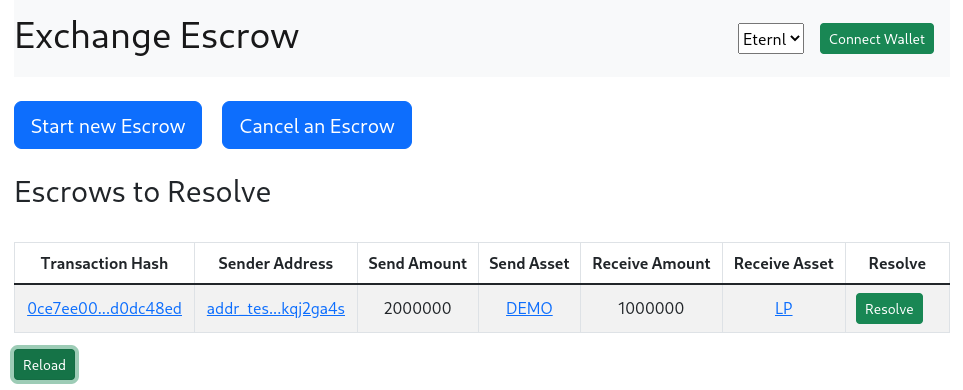5. Escrow frontend
The escrow frontend is a standard web application based on Node.js and React. In the frontend, all the pieces are connected together to support the complete functionality provided by the escrow dApp.
5.1. User interface
The user interface is defined here
in the EscrowUI function. It is implemented following the frontend design
document. It looks as follows:

All the UI components interact with the modules contained in the
contractEndpoints folder, where the main class and necessary datatypes are
defined.
5.2. Main class
Our approach is to define a single main class EscrowEndpoints that is in
charge of providing the complete end-to-end flow for every dApp operation and
also for providing the information we want to show in the user interface.
To instantiate we call:
connect(walletName: "nami" | "eternl")
At instantiation, a contract instance is activated in the PAB by using the
ContractEndpoints module. Also, a connection to the budget service is
initialized, and Blockfrost is queried to obtain the protocol parameters and
create an instance of the balancer.
Other important parameters are taken from the environment using the getEnvs
function:
REACT_APP_PAB_URL: PAB URLREACT_APP_BUDGET_URL: Budget service URLREACT_APP_BLOCKFROST_URL: Blockfrost URLREACT_APP_BLOCKFROST_API_KEY: Blockfrost API token
Once instantiated, the available methods are:
start(sp: StartParams)cancel(cp: CancelParams)resolve(rp: ResolveParams)reload()
Methods start, cancel and resolve corresponds to dApp operations,
so they all follow the same implementation pattern:
Obtain an unbalanced transaction from the PAB by calling
doOperationof the contract endpoints.Balance the transaction by calling
fullBalanceTxof the balancer.Sign and submit the transaction by calling signAndSubmit of the wallet.
Last, reload method returns the list of escrow than can be resolved by
calling reload of the contract endpoints to get the observable state.
5.3. Parameters
As we are using typescript, together with the main class, we define dApp
specific datatypes. A first group of types is defined in parameters.tsx and
is used to build valid parameters for the endpoint calls:
StartParamsCancelParamsResolveParams
The type definitions must match the format expected by the PAB, as defined in the Haskell interface and described in the endpoints specification document.
Together with the types, we define Haskell-style “smart constructors” to be able to easily build the parameters from the primitive javascript types used in the HTML forms.
5.4. Observable state
Another group of types is related to the observable state provided by the PAB and the information displayed in the UI.
The type PABObservableState represents the observable exactly as returned
by the reload method of ContractEndpoints, and therefore it must match the
JSON format of the observable state field returned by the PAB’s status endpoint.
For the escrow, the observable state has the Haskell type [UtxoEscrowInfo]
which has a default JSON serialization by deriving the ToJSON class
instantiation.
In the frontend code, we choose to parse the PAB’s observable state and return
a more UI friendly type ObsState, defined as a list of objects of type
EscrowInfo.